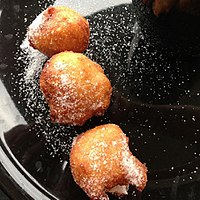
A doughnut or donut is a type of food made from leavened fried dough. It is popular in many countries and is prepared in various forms as a sweet snack that can be homemade or purchased in bakeries, supermarkets, food stalls, and franchised specialty vendors. Doughnut is the traditional spelling, while donut is the simplified version; the terms are used interchangeably.

Beignet is a type of fritter, or deep-fried pastry, made from pâte à choux, but may also be made from other types of dough, including yeast dough. In France there are at least 20 different versions. They can vary in shape, the flour used for the dough, and the filling. They are popular in French, Italian, and French-American cuisines.

Dough is a thick, malleable, sometimes elastic paste made from grains or from leguminous or chestnut crops. Dough is typically made by mixing flour with a small amount of water or other liquid and sometimes includes yeast or other leavening agents, as well as ingredients such as fats or flavorings.

A fritter is a portion of meat, seafood, fruit, vegetables, or other ingredients which have been battered or breaded, or just a portion of dough without further ingredients, that is deep-fried. Fritters are prepared in both sweet and savory varieties.

Æbleskiver are spherical Danish snacks made from fried batter. The name literally means "apple slices" in Danish, although apples are not usually an ingredient in present-day versions. The crust is similar in texture to European pancakes, but with a light and fluffy interior similar to a Yorkshire pudding. The English language spelling is usually aebleskiver,ebleskiver or ebelskiver.

Choux pastry, or pâte à choux, is a delicate pastry dough used in many pastries. The essential ingredients are butter, water, flour and eggs.

Puri is a deep-fried bread made from unleavened whole-wheat flour that originated in the Indian subcontinent. It is eaten for breakfast or as a snack or light meal. It is usually served with a savory curry or bhaji, as in puri bhaji, but may also be eaten with sweet dishes.
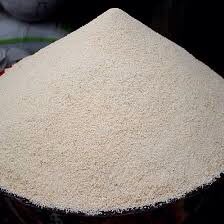
In West Africa, garri is the flour of the fresh starchy cassava root.

A buñuelo (Spanish:[buˈɲwelo], alternatively called boñuelo, bimuelo, birmuelo, bermuelo, bumuelo, burmuelo, or bonuelo, is a fried dough fritter found in Spain, Latin America, and other regions with a historical connection to Spaniards, including Southwest Europe, the Balkans, Anatolia, and other parts of Asia and North Africa. Buñuelos are traditionally prepared at Christmas. It will usually have a filling or a topping. In Mexican cuisine, it is often served with a syrup made with piloncillo.

Ghanaian cuisines refer to the meals of the Ghanaian people. The main dishes of Ghana are organized around starchy staple foods, which goes with either sauce or soup accompanied with a source of protein. The main ingredients for the vast majority of soups and stews are; tomatoes, hot peppers and onions. Most Ghanaian soups and stews are red or orange in appearance as a result of the main ingredients used.

Kue is an Indonesian bite-sized snack or dessert food. Kue is a fairly broad term in Indonesian to describe a wide variety of snacks including cakes, cookies, fritters, pies, scones, and patisserie. Kue are made from a variety of ingredients in various forms; some are steamed, fried or baked. Kue are popular snacks in Indonesia, which has the largest variety of kue. Because of the countries' historical colonial ties, Koeé (kue) is also popular in the Netherlands.
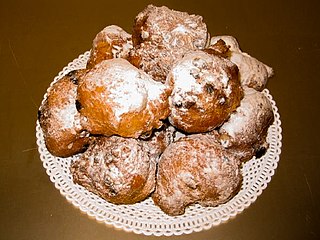
An oliebol is a Dutch beignet.

Nigerian cuisine consists of dishes or food items from the hundreds of Native African ethnic groups that comprise Nigeria. Like other West African cuisines, it uses spices and herbs with palm or groundnut oil to create deeply flavored sauces and soups.
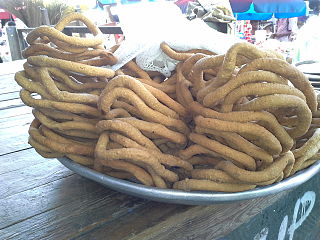
Kuli-kuli is a West African snack primarily made from peanuts, first made by the various ethnic groups including the Nupe people of Nigeria and Dagbon people of Ghana. It is a popular snack in Nigeria, Benin, northern Cameroon and Ghana. It is often eaten alone or with a mixture of garri also known as cassava flakes, sugar and water, popularly called "garri soakings". It is also eaten with Hausa koko, fura, and kamu, and is sometimes ground and put into salad. It is often ground and used as an ingredient for suya and kilishi.

Chin chin is a fried snack from Nigeria. It is known as atchomon in Togo and Benin, achomo in Ghana, and croquette or Chin Chin in Cameroon.

A great variety of cassava-based dishes are consumed in the regions where cassava is cultivated, and the ingredient is included many national or ethnic specialities.
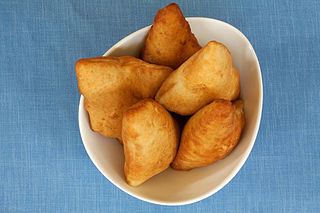
Mandazi is a form of fried bread that originated on the Swahili Coast. It is also known as bofrot or puff puff in Western African countries such as Ghana and Nigeria. It is one of the principal dishes in the cuisine of the Swahili people who inhabit the Coastal Region of Kenya and Tanzania. The dish is popular in the region, as it is convenient to make, can be eaten with almost any food or dips or just as a snack by itself, and can be saved and reheated for later consumption.
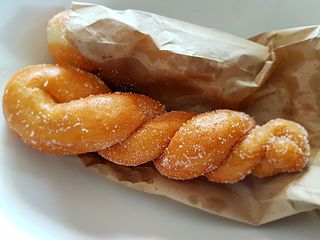
Twisted doughnuts are yeast donuts or sticks of pastry made from wheat flour or glutinous rice flour, deep-fried in oil. In China, they are known as mahua (麻花); in Korea, they are known as kkwabaegi (꽈배기) in the Philippines, they are known as shakoy and pilipit, in Japan, they are known as sakubei.
Hausa cuisines are traditional and modern food prepared by Hausa people. It is based on the availability of raw food materials they can farm or provide from other places. Most times Hausa people depend purely on the farm products they have cultivated for food preparations. Hausa people have a meal that is common to most Zongo communities called Tuo Zaafi.
